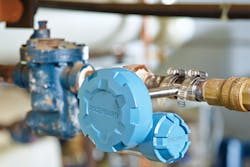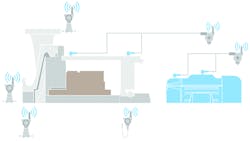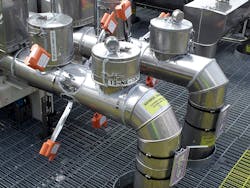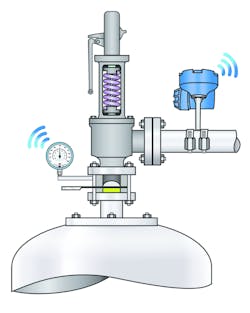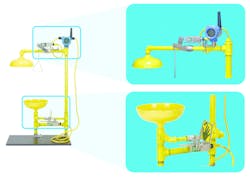A few decades back, most homes had to be visited each month by several meter readers carrying clipboards and reading the water, gas and electric meters so utilities could prepare their monthly bills. Naturally this was a time- and labor-intensive method, subject to reading and recording errors.
Today, many utilities, especially electric power providers, have moved to smart meters so user data can be sent to a central location continuously and automatically. Besides billing data, consumption patterns can be analyzed, and outages pinpointed. The utility knows what is going on within its system all the time, with no house-to-house visits required.
These new technologies are making meter readers a thing of the past, but many process manufacturers do something similar when they use manual rounds for equipment condition monitoring. As maintenance technicians patrol the facility looking for problems, they may ask:
- Is this steam trap leaking?
- Is that motor making more noise than usual?
- Is the pressure relief valve on top of this tank fully closed?
Some plants have these manual rounds carefully organized and scheduled, sending individuals out at prescribed intervals with ultrasonic listening devices, machinery vibration analyzers and infrared temperature readers to look for developing problems. If they are careful and methodical enough, a technician might catch a problem using those portable diagnostic tools while there is still time to schedule a repair before a failure and outage. In other plants, these efforts are more haphazard.
In either case, issues still arise because technicians simply do not have the time to check equipment often enough, and because results vary from one person to the next. This is also an expensive and labor-intensive way to gather diagnostic information. Moreover, using portable diagnostic equipment usually requires being close to running installations, which poses a variety of safety concerns.
Continuous monitoring where it counts
If a facility is heavily dependent on a few critical pieces of equipment, those probably have a range of key diagnostic devices permanently installed. If, for example, production hinges on a large compressor, it will likely have vibration transducers on all the bearings, and probably some strategically placed temperature transmitters.
When originally installed, these transducers and transmitters were probably connected to the plant’s automation or reliability system to capture and record the data. A human machine interface (HMI) would then show operators or the maintenance department what was happening, and would trigger alarms to warn if any variables moved out of safe ranges.
All of these monitoring components had to be installed and wired, often at considerable expense, which is why they were added only to the most critical piece of equipment. Many other installations within the facility could have benefited from the same treatment, but the costs were simply too high.
Fortunately, new approaches provide ways to monitor existing and new equipment at much more reasonable cost, and with less disruption to existing operations. The key is using modern industrial wireless technology, specifically WirelessHART.
WirelessHART has been one of the industry standards for wireless communications for the past 10 years. It is supported by dozens of vendors and administered by the independent FieldComm Group organization. Because wireless networks do not require a wired infrastructure, a wireless transmitter can be installed for one-third to one-fifth the cost of a wired 4-20mA or fieldbus transmitter.
Figure 2. Condition monitoring of a pump calls for a variety of transmitters to capture critical data.
Bringing consumer electronic advantages to industry
For decades, military and industrial users were the key drivers and developers of new technologies that ultimately found their way to consumers. With the coming of the 21st century, this changed. Now consumer electronics are the drivers and industrial users are trying to keep up.
Smartphones and tablets are everywhere and fully integrated into daily activities. Wireless communication makes anything accessible from anywhere. Who needs to pull cables? If one wants to read information from a smart thermostat on a phone, one downloads the app. No custom programming is needed because it is fully self-configuring and just works. Industrial applications are adopting the same mindset.
For example, let us apply that approach to an industrial application, say a critical pump installation (see Figure 2). It can be outfitted with different types of transmitters to monitor a variety of performance characteristics:
- Pressure transmitters to measure pressure at the inlet and outlet (suction and discharge)
- Vibration transmitters for the bearings
- Seal condition monitoring transmitters
- Temperature transmitters on the pump and motor
- Flowmeter transmitters for the main outlet
All of these transmitters are available with WirelessHART communications, so no signal wiring is needed. Power wiring is not needed because each transmitter has an internal power module. The transmitters organize their own network and communicate with a single gateway. The gateway communicates with the plant’s larger network via hardwired data link, usually Modbus or Ethernet, so the data can be sent anywhere the network reaches.
Once a WirelessHART infrastructure is set up to monitor one or more pieces of equipment, additional wireless
instruments can be added at marginal cost, with each one joining the network.
Goodbye to custom software
Data capture, analysis and presentation are performed using preconfigured apps that can communicate with the gateway via the plant network or through cloud connections. Using a wireless smart device with the app installed allows any authorized user to access the information produced by the app. Using a simple, actionable interface, users can see exactly what they want with no custom programming required. The pump app can monitor:
- Strainer differential pressure
- Seal pressure and level
- Vibration analysis
- Cavitation
- Process variable thresholds based on baseline capture
- Other specialized variables
Custom software is unnecessary because the apps collect raw data from these monitoring points and perform analytics to determine the condition of plant equipment and assets. This provides users with greater visibility into operations, enabling improved reliability, energy efficiency and better decision-making.
These types of industrial apps are becoming a common way for vendors to supply software to end users, supplanting more traditional software products and accompanying custom programming. Like smartphone and tablet apps, these apps are lightweight and low-cost, requiring little corporate IT support.
These software apps utilize prebuilt analytics with embedded domain expertise to diagnose the health of a specific type of plant asset. The resulting information and insights can be accessed and visualized on a web-user interface running on PCs, laptops, tablets or smartphones. Prebuilt dashboard and chart templates make navigation and interpretation of information simple, so minimal training is required. The apps include features to ensure security, including role-based access.
Remote is not always far away
Talking about remote monitoring suggests the individual looking for information is far off, but as the internet and smart devices have demonstrated, physical distance is not as important as it once was. Given the choice of calling up the pump monitoring app or going out and poking around the installation the hard way, someone in the plant standing next to the pump itself is probably going to use the app. And why not? All the information is there in a dashboard presentation, available with a few finger pokes on the touchscreen. The only reason to go to the equipment is for situations in which visual inspection is required.
Therefore, monitoring can be carried out in a plant or outside it, by either plant personnel or by corporate engineers at a central location. Each of these scenarios may call for differences in presentation or degree of granularity, but this is not a problem since the app is suited for a wide range of users.
Typical equipment monitoring applications
Many types of equipment are suited to wireless monitoring and app-based solutions:
- Pumps
- Steam traps
- Heat exchangers
- Pipes and vessels subject to corrosion
- Relief valves
- Safety shower and eye wash stations
Now let us look at some of the other typical use cases.
Steam trap monitoring — Steam traps (see Figure 1) are often monitored via manual rounds, during which maintenance technicians test traps once or twice a year and look for signs of leaking. Much of the analysis depends on the judgment of the person making the measurements and observations. Estimates suggest that 18 percent of the steam traps in a typical large petrochemical plant fail every year, each causing about $16,000 in extra fuel and steam costs.
By installing wireless acoustic transmitters and a steam trap app, plants can quickly identify steam traps that fail to open or close, are leaking, or are working improperly. Acoustic steam trap monitors simply clamp on to the steam line, so there is no need to shut down the process during installation. The acoustic monitor "listens" to the steam line and transmits data to the gateway. Information from the gateway is then sent to a steam trap app, which uses an algorithm to identify failure modes (good, blow through, cold or inactive).
Figure 3. Corrosion monitoring systems, such as Emerson’s Permasense, can measure pipe wall thickness continuously, which allows quick detection of deterioration.
Heat exchanger monitoring — Data from wireless temperature, pressure and other transmitters installed on heat exchangers can be analyzed to identify abnormal situations, such as early detection of accelerated fouling. Analysis also determines the optimal time to clean the exchanger based on heat transfer degradation and economic calculations. The heat exchanger app provides in-depth monitoring of shell and tube heat exchangers. It can determine:
Figure 4. Pressure relief valves that chatter or simmer release process fluids, losing product and causing environmental impact.
- Real-time heat exchanger status and alerts
- Heat duty
- Fouling factor and rates
- Heat transfer coefficient
- Process variable thresholds based on baseline capture
Corrosion monitoring — Corrosion and erosion can cause serious deterioration of plant equipment and infrastructure, often with dire consequences. Wireless, nonintrusive corrosion monitoring (see Figure 3) allows users immediate visibility into pipe thickness — the best indicator of corrosion. A corrosion-monitoring app provides further visibility into pipe integrity and corrosion/erosion rates. Taking in data from numerous point sensors, the app provides deep understanding and immediate notification of problem areas and equipment degradation before leaks or spills occur, optimizing operations and improving safety.
Pressure relief valves (PRVs) — Most PRVs are installed in difficult-to-reach areas, often on top of high installations. When they open to release process fluids to a flare or scrubber, they do not always close fully because of debris or seal deterioration (see Figure 4). These valves continue to simmer or chatter, slowly releasing product and causing environmental impact. An acoustic transmitter can be mounted on the pipe next to the valve to listen for these characteristic sounds. An algorithm in the PRV app can identify these signs and indicate which valves need attention.
Safety shower and eyewash stations — Most plants have many of these installations, but they are typically unmonitored. A worker who needs attention may have to call for help on the plant radio or hope to be spotted by colleague. With a simple WirelessHART valve monitoring device (see Figure 5), any activation of a shower or eyewash can immediately report the situation and location to the control room and first responders in the plant.
Figure 5. Adding WirelessHART monitoring at safety shower installations can call for help even if a worker is in distress.
Wireless instrumentation and accompanying apps simplify the installation, configuration and maintenance of equipment monitoring systems. These systems can be brought online at a fraction of the cost of traditional wired transmitters and complex, enterprise-wide analysis software. In many cases, payback is achieved in months, and an initial system can be installed at minimal cost to prove viability.
Brian Joe is the Rosemount wireless product manager for Emerson Automation Solutions responsible for analytic apps and solutions. He has a BSME from Purdue University and a Bachelor of Science in economics from Butler University. Joe has worked with multiple Emerson businesses in various marketing, business development, strategy and operations roles.
Brian Joe
Brian Joe is a wireless product manager for Emerson’s Automation Solutions business in Shakopee, Minnesota, responsible for analytic applications and solutions. He holds a Bachelor of Science in mechanical engineering from Purdue University and a Bachelor of Science in economics from Butler University.
